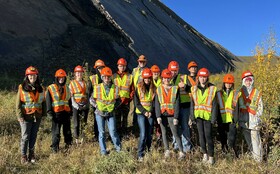GNS: GCCHS Students Visit Local Coal Mine
Posted on:
The Environmental Stewardship Class from Grande Cache Community High School (GCCHS) visited their local coal mine, CST Canada Coal Limited (“CST Coal”). At CST Coal, students learned firsthand how coal is formed, extracted, and used, and the best management practices that are followed to mitigate potential impacts on the environment. Connor Burdett, a biologist and resource management technologist at CST Coal, supervised and guided their tour.
First, students rode the bus to a high-altitude viewpoint of No. 8 Mine, where they were fortunate to watch active mining operations involving heavy equipment (e.g. ‘shovels’). It was at No. 8 Mine where the group met up with geologists Brian Klappstein and Sylvan Burdett. Brian and Sylvan helped the class understand which types of coal are desirable for industrial processes and which type of coal is the primary focus at CST Coal. It just so happens that Grande Cache is a location rich in metallurgical coal, or coking coal, which is good quality coal that can be used in blast furnaces to make steel. In this setting, students were able to make real-world connections involving the extraction of natural resources (i.e. coal) and the production of materials (i.e. steel). Brian and Sylvan also helped answer student questions like, “how does CST Coal find the coal seams?” and “who decides where to mine?” They also discussed important business decisions that must be made related to the feasibility of coal mining, some alternative forms of energy that can be used in low-scale production of steel, and what the future might look like for generations to come.
Their second stop on the tour was at a settling pond near Sheep Creek, where students observed how surface water that may be impacted by mining operations is purified prior to discharge. In addition to allowing solids to settle out, the settling pond also contained bio-remedial plants which are intended to remove toxic compounds, such as selenium, from the water. Students were able to make important connections between bioremediation and some of the plants they recognized (e.g. fireweed).
The third stop on the tour was near No. 12 Mine, which contains palaeontological resources (dinosaur tracks). Students were able to observe a 110 million-year-old track site containing Ankylosaur tracks, theropod tracks, and avian (bird) tracks. The discovery of this track site, found by coal mine workers is important because it gives information about how some dinosaurs got around and that they lived in groups. The field trip to CST Coal was a successful, eye-opening experience that GCCHS hopes to repeat with additional groups of students in the future. On behalf of GCCHS, a HUGE thank you to the staff at CST Coal for facilitating this learning opportunity for the students.








































